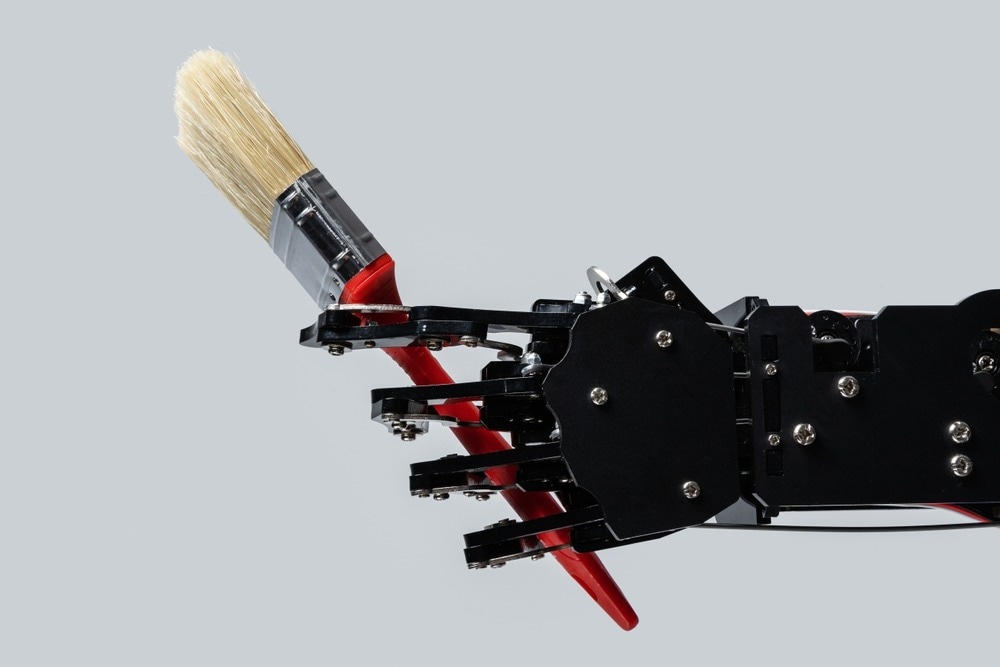Achieving a smooth and polished surface for walls and ceilings traditionally required skilled plasterers. However, robotic systems equipped with sophisticated algorithms and sensors that allow them to analyze surface irregularities and apply the appropriate amount of plaster or drywall compound have emerged to take on this task with remarkable precision, resulting in a consistent finish that meets the desired specifications, eliminating the need for time-consuming manual corrections.
One of the primary finishing tasks in construction is painting and coating surfaces. Robots equipped with advanced sensors and precision control systems can navigate complex structures, ensuring an even coat of paint or protective finish. This expedites the process and minimizes waste, as the robots can optimize the material used based on surface irregularities.
For instance, researchers in a 2022 study designed an autonomous wall painting robot for interior residential buildings, featuring a mobile robot base with an arm for lateral feed motion. The study discussed integrating motor drivers, IR sensors, and a sprayer unit for precise and automated wall painting, enhancing efficiency and safety in construction processes.
Tile and Flooring Installation
Automated robotics systems can navigate spaces, lay tiles, and install flooring materials with unparalleled accuracy, accelerating the construction timeline and ensuring a level of precision that is challenging to achieve consistently through manual labor. Additionally, robots can work continuously without fatigue, enhancing overall project efficiency.
Advantages of Robotic Finishing in Construction
There are many advantages of using robots in construction finishing tasks over traditional approaches, including high speed, efficiency, accuracy, consistency, safety and risk mitigation.
Speed and Efficiency
Robots excel in repetitive and precise tasks, enabling them to complete finishing jobs at a high pace as compared to human labor. This accelerated speed contributes to shorter construction timelines, allowing projects to be completed on schedule. Moreover, robots can analyze surfaces, detect imperfections, and apply materials with consistent accuracy, ensuring a high-quality finish throughout the construction project. This level of precision is challenging to achieve consistently through manual labor, where factors such as fatigue and human error can come into play.
Safety and Risk Mitigation
Construction sites can be hazardous environments, and finishing tasks often involve working at heights or in confined spaces. Robots are designed to operate in such conditions without the need for human intervention, thereby reducing the risk of accidents and injuries. Construction companies can prioritize worker safety and minimize potential liabilities by delegating finishing tasks to robots.

Image Credit: BLACKDAY/Shutterstock.com
Commercial Examples
Canvas is a company creating a new class of worker-operated robots for construction that use computer vision and artificial intelligence to identify different wall types and provide customized solutions. Canvas robots are built using a combination of robotics, artificial intelligence, machine learning, and Lidar/3D technologies.
At present, the robots developed by Canvas demonstrate an impressive capability, successfully undertaking 40% of an entire paint project. Through ongoing iterations and enhancements to the machine's components, Canvas is actively striving to elevate the machine's efficiency to an impressive 70%. Notably, the Canvas machine presently boasts the ability to provide expert-quality Level 4 targeted spray and Level 5 finishes, showcasing its advanced and precise painting capabilities.
Recent Developments
In a recent study, researchers have addressed challenges in the construction industry by proposing a novel approach to integrate robots into finishing tasks. The study focuses on utilizing reinforcement learning (RL) to train two construction robots—an unmanned ground vehicle (UGV) and a robot arm—to collaboratively transport and install window panels. Unlike existing RL-based construction robots that operate individually, this approach demonstrates successful collaboration between the UGV and robot arm, achieving a commendable 79.6% success rate in completing tasks in an end-to-end manner.
The study emphasizes the need for construction robots to work collaboratively, akin to on-site teams, and highlights the potential of RL in enhancing adaptability and flexibility in construction tasks. The researchers conducted experiments using a physics simulation engine, Pybullet, and emphasized the importance of training robots in simulation before real-world deployment. The results showcase promising advancements in automating sequential construction tasks through collaborative efforts of RL-trained robots.
Challenges and Future Developments
While robots have demonstrated success in controlled environments, adapting to the unpredictable nature of construction sites remains challenging. Developing robots that can navigate complex, dynamic spaces with changing conditions is an ongoing area of research. Overcoming this challenge will further expand the applications of robots in construction finishing.
Achieving seamless collaboration between robots and human workers is crucial for the widespread adoption of robotic finishing systems. The industry is exploring ways to integrate robots into construction teams, emphasizing collaboration rather than replacement, which may involve training workers to operate and supervise robotic systems or developing interfaces that facilitate communication between humans and robots on the construction site.
As technology continues to advance, so do the capabilities of robotic systems. Future developments may include enhanced sensing capabilities, improved machine learning algorithms, and the integration of artificial intelligence to make robots more adaptable and intuitive in responding to diverse finishing challenges.
References and Further Reading
Huang, L. & Zou, Z. (2022). Deep reinforcement learning-based construction robots collaboration for sequential tasks. In Proceedings of the 1st Future of Construction Workshop at the International Conference on Robotics and Automation. International Association for Automation and Robotics in Construction (IAARC). Available at: https://construction-robots.github.io/papers/12.pdf
Kumar, V. P., et al. (2016). Robotics in construction industry. Indian Journal of Science and Technology. dx.doi.org/10.17485/ijst/2016/v9i23/95974
Kumtole, S., et al. (2022). Automatic wall painting robot Automatic wall painting robot. Journal of Image Processing and Intelligent Remote Sensing (JIPIRS). doi.org/10.55529/jipirs.26.11.22
Mitterberger, D., et al. (2022, April). Interactive robotic plastering: Augmented interactive design and fabrication for on-site robotic plastering. In Proceedings of the 2022 CHI Conference on Human Factors in Computing Systems. doi.org/10.1145/3491102.3501842
Canvas. Available at: https://www.canvas.build/about
Disclaimer: The views expressed here are those of the author expressed in their private capacity and do not necessarily represent the views of AZoM.com Limited T/A AZoNetwork the owner and operator of this website. This disclaimer forms part of the Terms and conditions of use of this website.